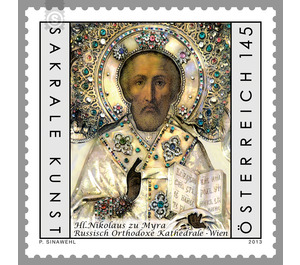Sacred art - Austria / II. Republic of Austria 2013 - 145 Euro Cent
Theme: Architecture
| Country | Austria / II. Republic of Austria |
| Issue Date | 2013 |
| Face Value | 145.00 |
| Edition Issued | 270,000 |
| Printing Type | combination printing |
| Stamp Type | Commemorative |
| Item Type | Stamp |
| Chronological Issue Number | 2436 |
| Chronological Chapter | OOS-OE2 |
| SID | 619982 |
| In 60 Wishlists | |
With the present special stamp, the attractive series "Sacred Art in Austria" now finds its aesthetic continuation. The brand motif shows the impressive icon of St. Nicholas of Myra from the Russian Orthodox Cathedral in Vienna's 3rd district. The late-historic church, seat of the Russian Orthodox community of Vienna and since 1962 its own eparchy, was built from 1893 to 1899 according to the plans of a certain Grigory Ivanovich Kotov by the Italian architect Luigi Giacomelli as a church embassy. Much of the construction cost, namely 400,000 rubles, was at that time by a donation of Tsar Alexander III. applied. The consecration of the cathedral to St. Nicholas took place in April 1899, as episcopal seat of the eparchy for Vienna and Austria, it is directly subordinate to the Moscow Patriarchate. The imposing church, a five-cupola building in the traditional forms of Russian sacral architecture, was extensively renovated between 2003 and 2008. The interior is divided into a lower and an upper church, patron of the upper church is the above-mentioned St. Nicholas. About the person: Nicholas of Myra is undoubtedly one of the most popular saints of both the Eastern and the Western Church. In the first half of the 4th century, he served as Bishop of Myra in the Asia Minor region of Lycia, which at that time was part of the Roman Empire and later of the Byzantine Empire. There are only a few proven facts about the life of the historical Nicholas. Myra in Lycia, today Demre, is a small town about 100 kilometers southwest of Antalya in today's Turkey. In the 4th century, the place was a bishopric. Sources of Nicholas' life come, for example, from Andrew of Crete (c. 700) and from a monk named John from the convent in Constantinople, founded in the 5th century. According to consistent traditions Nicholas was born between 270 and 286 in Patara. At the age of 19, he was ordained a priest, later to be abbot of the Sion Monastery near Myra. During the persecution of Christians he was, according to tradition, captured and tortured. As the son of rich parents, Nicholas is said to have distributed his inherited wealth among the poor, as is also reported by the better-testified bishops of the 4th century, Ambrose of Milan and Basil of Caesarea, and considered a historical fact in the case of Nicholas of Myra Therefore, the most diverse legends and regional customs are entwined.


